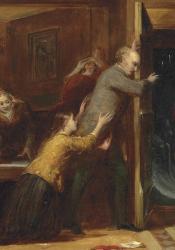Fallen Women in Victorian Art
This article shows the highlighted negativity that was associated with the “fallen woman” during the Victorian Era. During the Victorian Era, it was finally socially acceptable to use this as a subject in paintings and art. These were meant to be used as warnings for all women out there—to see the potential downfall that was ahead of you if you didn’t stay virtuous. Going through time, you can see a slight shift in the subjects and stories behind these paintings. At first, it is one young woman being cast away by her father and family (Richard

